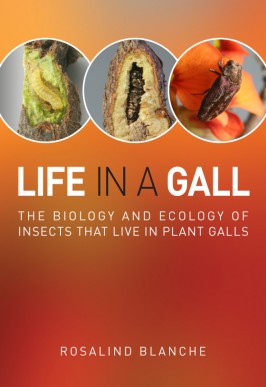The Biology and Ecology of Insects that Live in Plant Galls
This comprehensive handbook, complete with full colour photos will be a useful tool for entomologists, botanists, natural history enthusiasts and native plant nursery managers as well as bushwalkers, forestry students and managers.
Gall-inducing insects can cause problems for agriculture, forestry and horticulture and this book covers the whole gamut from explaining what Australian plant galls are and how they are caused, the little known gall-inducing insects and their host plants to the problems they cause, their enemies and also the benefits associated with gall-inducing insects.
The book explores the ways the insects have adapted to living part of their lives in the confined spaces of galls, and describes the strategies employed by different insect groups to find a suitable site to induce a gall, obtain food, mate and escape the gall. It also looks at the predators, parasitoids, inquilines, kleptoparasites and micro-organisms that prey on gall-inducing insects and the ways the insects defend themselves from these enemies, giving examples of several pest species.
On the positive side, the book describes the essential services gall-inducing insects provide by pollinating figs, controlling invasive weeds and contributing to indigenous food. There are also tips for people who want to collect and study galls and a glossary of scientific terms making this a useful title to a wide range of readers. Buy it from an independent bookshop, borrow it from a library or buy a copy online at the CSIRO website
by Rosalind Blanche, CSIRO Publishing, $29.95.
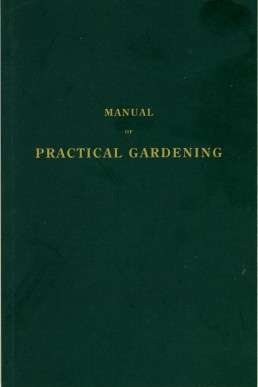 Adapted to the climate of Van Dieman’s Land:
Adapted to the climate of Van Dieman’s Land:
Containing Plain and Familiar Directions for the Management of the Kitchen, Fruit, and Flower Garden, Nursery, Green-House, and Forcing Department.
For every month of the year.
By Daniel Bunce
This fascinating facsimile of the original book written by Daniel Bunce in 1838 looks at gardening month by month in the new colony. Daniel Bunce arrived in Hobart in 1833 after establishing his own nursery he published his ‘Practical Gardening’ month by month, starting with July. When it was finished, all the monthly bulletins were bound together and sold to the general public. In 1857 Bunce was appointed Curator of the Geelong Botanic Gardens. This facsimile has been published by The Friends of the Geelong Botanic Gardens and copies can be obtained by emailing The Friends at [email protected]
So I looked to see what I should be doing this month and found that I should be sowing spinach and parsnip seed, planting out cabbage and cauliflower seedlings, blanching endive and manuring artichoke plants. All still absolutely right and relevant today, nearly 175 years later. The pages are full of gardening wisdom, such as this last comment for July ‘Every part of the garden should now be kept very clean (of weeds), as if the seeds are suffered to grow they will get ahead and prove troublesome all the following season.’
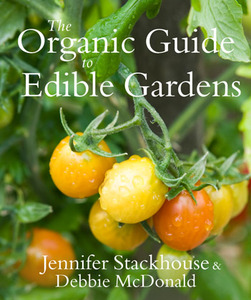 This lovely book is the perfect introduction to edible organic gardening. It is packed with clear and accessible information and photographs about composting, soils, pests and diseases, as well as an A-Z of edible plants. It also explains in simple terms how to get started, what is meant by terms like organic, permaculture and biodynamic and how to test your soil. Scattered through the book there are clear step-by-step pictures of making no-dig gardens and vegetable beds, as well as growing green manure and laying irrigation systems, how to espalier and much more. While probably more suited to the beginner gardener, there is also information here for the more experienced gardener. A great addition to the organic gardening literature; you would expect no less from two such knowledgeable garden writers.
This lovely book is the perfect introduction to edible organic gardening. It is packed with clear and accessible information and photographs about composting, soils, pests and diseases, as well as an A-Z of edible plants. It also explains in simple terms how to get started, what is meant by terms like organic, permaculture and biodynamic and how to test your soil. Scattered through the book there are clear step-by-step pictures of making no-dig gardens and vegetable beds, as well as growing green manure and laying irrigation systems, how to espalier and much more. While probably more suited to the beginner gardener, there is also information here for the more experienced gardener. A great addition to the organic gardening literature; you would expect no less from two such knowledgeable garden writers.
Borrow it from you library or buy it from your local independent book shop.
by Jennifer Stackhouse & Debbie McDonald, Murdoch Books, $29.95 (digital copies $19.95)
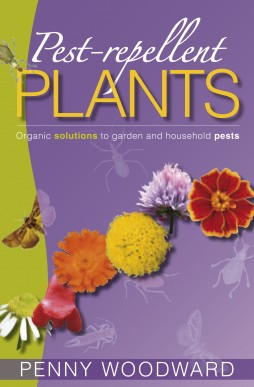 By Gail Thomas for Australian Horticulture.
By Gail Thomas for Australian Horticulture.
(reproduced with permission)
If the pests are taking hold, this useful reference has plenty of quick and easy organic solutions to getting the upper hand in both the garden and home.
With a host of ideas, strategies and answers this new revised edition has been updated and expanded, documenting more than sixty relevant plants along with traps, barriers, sprays and more to assist in addressing all manner of pest problems while maintaining a healthy balanced lifestyle and garden.
Penny Woodward who has a wealth of knowledge, having penned seven herb and garden related books has divided the plants and recipes in this volume into four categories; those that will kill pests, actively repel them, those that can mask the scents of plants targeted by pests and those that will kill or control fungi and bacteria.
Importantly it is imperative to take a holistic approach in maintaining a balance between pests and predators and the book also features tips and safety guidelines when making and using homemade pesticides.
The comprehensive A-Z of plants and organic remedies is fully illustrated with clear colour photographs throughout and also includes recipes using many easily accessible household ingredients including coffee, bicarbonate of soda, milk, molasses, flour and garlic. Continue Reading
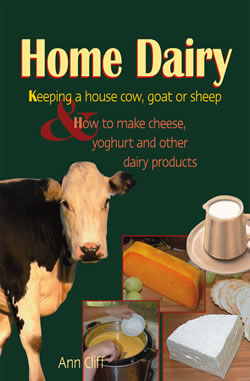 Keeping a house cow, goat or sheep & How to make cheese, yoghurt and other dairy products
Keeping a house cow, goat or sheep & How to make cheese, yoghurt and other dairy products
Ann Cliff
Ann Cliff’s thorough approach to this book is very similar to her earlier one on bees, The Bee Book. She looks at the story of milk, then how to care for dairy animals, and more specifically at cows, goats and sheep. Then the final chapters are on milk, cream, butter and cheese with clear and useful instructions for how to create your own milk based products. I can attest to the joy and heartache of keeping goats and how wonderful it is to have a seemingly endless supply of milk for soft and hard cheeses. Whether you want to embark on the journey of keeping dairy animals or just want to create butter, cheese, yoghurt, kefir, koumiss, ice-cream or soap then this is the book for you. Buy it from an independent bookshop, borrow it from the library or buy a copy online from the store.
Hyland House, 2011, PB, full-colour, 160 pp, $24.95
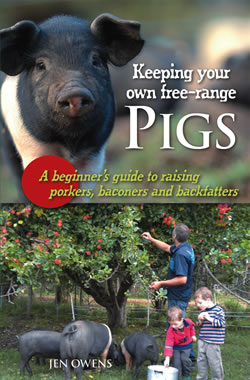 A beginner’s guide to raising porkers, baconers and backfatters
A beginner’s guide to raising porkers, baconers and backfatters
by Jen Owens
ISBN 9781864471175
I have only once kept a pig and for some reason, lost in the mists of time, we named her after my mother-in-law. No insult intended. I was very fond of the pig and my mother-in-law. And that is one of the difficult things about pigs, you do become very fond of them. So when it’s time to kill them it can be difficult. But Jen Owens takes a practical and no-nonsense approach to all aspects of owning and raising pigs, seeing it as more important to take responsibility for the meat she eats and to ensure that the animal it comes from has been respected and cared for during its lifetime. The book has chapters on choosing your pig, housing and fencing, food and water, breeding, health, D-Day (the abattoir and butcher) and porky products.
The perfect book for anyone wanting to raise pigs and eat their own pork and bacon. Buy it from your local bookshop, borrow it from your library or buy a copy online from the store
Sewn PB, full-colour, 144 pp, AUS$24.95
Yates Garden Guide 2011
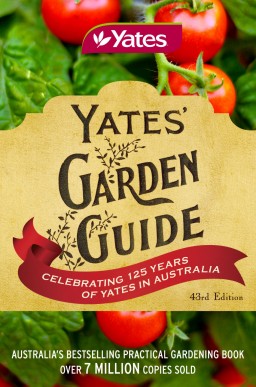 This 43rd edition of the classic Yates Garden Guide is special because it celebrates 125 years of Yates in Australia. I have always loved the clear layout and carefully chosen pictures. It is really easy to find an answer quickly to almost any gardening question. The obvious drawback is that many of the solutions to pest and disease problems are not organic. But Yates are also working to improve their organic profile and they now have (and have had for many years) several allowable organic products. The book has a chapter on the history of the guide, as well as one on organics and no dig gardening. Also soils, composts worms, propagating, gardening for the kitchen and then all the other things you can grow and do in the garden. I love it and refer to it often, but have learnt to ignore the non-organic advice. If you don’t have a recent edition then this would be a lovely one to buy with its links back 125 years. Buy if from your local independent bookshop, or borrow it from your library.
This 43rd edition of the classic Yates Garden Guide is special because it celebrates 125 years of Yates in Australia. I have always loved the clear layout and carefully chosen pictures. It is really easy to find an answer quickly to almost any gardening question. The obvious drawback is that many of the solutions to pest and disease problems are not organic. But Yates are also working to improve their organic profile and they now have (and have had for many years) several allowable organic products. The book has a chapter on the history of the guide, as well as one on organics and no dig gardening. Also soils, composts worms, propagating, gardening for the kitchen and then all the other things you can grow and do in the garden. I love it and refer to it often, but have learnt to ignore the non-organic advice. If you don’t have a recent edition then this would be a lovely one to buy with its links back 125 years. Buy if from your local independent bookshop, or borrow it from your library.
Yates Garden Guide 2011, HarperCollins, 2011, soft cover, 506 pages, $39.95
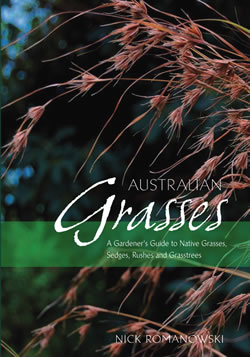 Australian Grasses, A gardener’s guide to native grasses, sedges, rushes and grasstrees.
Australian Grasses, A gardener’s guide to native grasses, sedges, rushes and grasstrees.
Introduced grasses have been popular in our gardens for many years now but not native grasses. To help encourage wider use of Australian grasses we have needed a well-written, accessible book on how to grow and use them, and finally we have one. Nick Romanowski obviously has a passion for, and wide-ranging knowledge of, this subject. In chapter 4 he profiles more than 200 native grasses, sedges, rushes and grasstrees and from the numerous photos we can see that many Australian grasses are as beautiful as the introduced grasses. They also have the added bonus of providing food and shelter to native animals, insects and birds, and unlike introduced grasses, very few of them are weeds or have weedy potential. The early chapters explain the differences between the different forms of grasses, as well as how they can be used in the average garden – lawns, borders, mounds, water gardens, bogs, formal and semi-formal beds and finally in pots. Growing, propagating, maintaining and even eating the grasses is also covered. Continue Reading
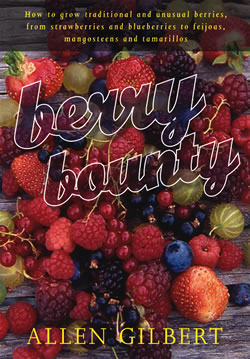 Berry Bounty, How to grow traditional and unusual berries, from strawberries and blueberries to feijoas, mangosteens and tamarillos.
Berry Bounty, How to grow traditional and unusual berries, from strawberries and blueberries to feijoas, mangosteens and tamarillos.
I’ve never quite mastered the art of growing berries but I’m hoping this book will make the difference. Allen Gilbert is a well-known and very experienced garden writer who has grown most of the berries described in the book. He is very much a hands-on gardener with books on citrus, tomatoes, nuts, apples and espalier already published. He starts this one by defining berries. Many plants that we think of as berries (strawberries and blackberries for instance) are not technically berries. While plants such as guavas, magosteens and persimmons are berries (botanically speaking). So the first part of the book covers those plants that are generally believed to be berries, namely blueberries, brambleberries, cranberries, currants, elderberries, gooseberries, jostaberries, mulberries, raspberries and strawberries. The second half looks at botanically true berries that are not included in the above list. Cape gooseberries, Chilean guava, feijoas, goji berries, guavas, jaboticabas, kiwi fruit, mangosteens, passionfruit, pawpaws, pepinos, pepperberries, persimmons, pomegranates and tamarillos. It is a great mixture of common and unusual fruits and covers everything from how to propagate, grow and harvest, to pests and diseases and how to deal with them organically, as well as some well-chosen recipes showing how to use the fruit when ripe. Continue Reading
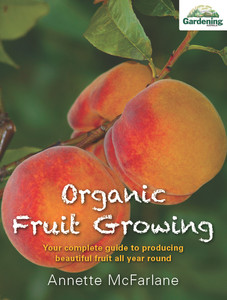 I have hundreds of gardening books in my library but only 20 or so on the ‘can’t manage without’ shelf. Organic Fruit Growing is going straight onto that shelf (Annette’s earlier book Organic Vegetable Gardening is already there). There are sections on getting started, easy fruits to start with and preparation, planting, pruning, pests, pollination and propagation. Then the A-Z with all the common fruit but also babaco, carambola, chocolate pudding fruit (tantalising?), granadilla, ice-cream bean, native limes, longan, pepino and vitamin C tree. How can you resist? Many of those I’ve just listed do best in regions with warm wet summers, but with strange things happening to our climate, who knows what we may soon be able to grow further south. I love Annette’s books because there is so much original material, written from personal experience. Whether you are a beginner or an experienced garden, this is a must have gardening book. Borrow it from your library, buy it from your local independent bookshop or go to Annette’s website to link to other Australian websites that sell the book.
I have hundreds of gardening books in my library but only 20 or so on the ‘can’t manage without’ shelf. Organic Fruit Growing is going straight onto that shelf (Annette’s earlier book Organic Vegetable Gardening is already there). There are sections on getting started, easy fruits to start with and preparation, planting, pruning, pests, pollination and propagation. Then the A-Z with all the common fruit but also babaco, carambola, chocolate pudding fruit (tantalising?), granadilla, ice-cream bean, native limes, longan, pepino and vitamin C tree. How can you resist? Many of those I’ve just listed do best in regions with warm wet summers, but with strange things happening to our climate, who knows what we may soon be able to grow further south. I love Annette’s books because there is so much original material, written from personal experience. Whether you are a beginner or an experienced garden, this is a must have gardening book. Borrow it from your library, buy it from your local independent bookshop or go to Annette’s website to link to other Australian websites that sell the book.
Organic Fruit Growing by Annette McFarlane, ABC Books, HarperCollins, Softcover, 223pages, $35

